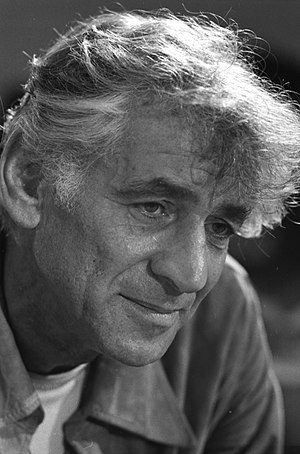Leonard Bernstein conducting William Schuman Symphony No.5 ("Symphony for Strings") with the New York Philharmonic
 |
| Leonard Bernstein (Photo credit: Wikipedia) |
2. Larghissimo 4:24
3. Presto 11:48
Although Schuman titled this work "Symphony for Strings in Three Movements," it is in fact the fifth of ten symphonies he composed between 1935 and 1975, the first and second of which he withdrew after a single performance each. On the title page is written "Commissioned by the Koussevitzky Foundation and dedicated to the memory of Mme. Natalie Koussevitzky." On November 12, 1943, Sergey Koussevitzky conducted the first performance with the Boston Symphony Orchestra's superlative strings. The Symphony No. 5 would become the most played and most popular of Schuman's symphonies, despite its complexities of rhythm, tonal density, and massively sonorous chordal textures at key points.
By 1943 Schuman's style was indelibly defined. His music had become as immediately recognizable as Brahms' or Sibelius', even in a work like the somberly atonal Symphony No. 6 (1948), which makes use Schoenbergian tone rows. Polyphony is the main ingredient of his music, polytonality the favorite seasoning. By then it had become a stylistic element in Schuman's developmental sections to have the top and bottom lines move in unison while all manner of intricacies, harmonic and rhythmic, pursued their own, usually agitated, course in between. At just 17 minutes in duration, the Symphony for Strings is among the shortest works in Schuman's symphonic catalogue.
The music begins Molto agitato ed energico. Unison violins play a 12-bar principal theme on the G string, repeated with pizzicati from the low strings. Violas introduce a vigoroso triple-forte second theme, marked by two groups of quadruplet rhythms derived from the principal subject. The balance of the movement is dominated by variants of the main subject.
The slow movement, marked Larghissimo, is basically chordal until the middle section, where the first violins introduce a syncopated rhythmic pattern over an irregularly rising scale in the contrabasses. Violins appropriate this until the principal material returns with appoggiaturas, after which mutes are added and the movement ends very softly.
The finale is an alla breve Presto whose main subject is an abbreviated version of the first movement's opening subject. Schuman freely adapts rondo form here with contrasting episodes, the second of which alternates with materials from the slow movement. The chordal coda resolves on a D major sonority.










